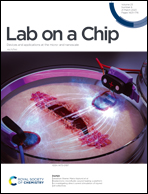On-demand microfluidic mixing by actuating integrated magnetic microwalls†
Abstract
Various types of passive and active micromixers have been successfully developed to address the problem of mixing in microfluidic devices. However, many applications do not need fluids to be mixed at all times, or indeed require mixing to be turned on and off at will. Achieving such on-demand mixing is not feasible for passive mixers, particularly when the flow rate cannot be used as a control parameter. On the other hand, active mixers are usually not designed to be able to turn mixing off completely, and they often have complicated fabrication processes and special operation requirements, limiting the range of applications. In this work, we demonstrate an on-demand micromixer based on the actuation of magnetic microwalls. These are made by replica micromoulding and can be easily integrated within commercial microfluidic devices, such as the ibidi® 3-in-1 μ-Slide. Using a simple magnet, the microwalls can be actuated between a fully upright ‘on’ state, which turns on mixing by creating a meandering path in the main channel, and a fully collapsed ‘off’ state, which completely turns off mixing by opening up the channel leaving it unobstructed. Besides the increase in path length when the microwalls are activated, inertia effects also play a significant role for mixing due to the tight bends in the meandering flow path. We quantify the mixing effect using coloured fluids of different viscosities and at different flow rates, and we show that the microwalls can effectively enhance mixing across a wide range of operational conditions.



 Please wait while we load your content...
Please wait while we load your content...